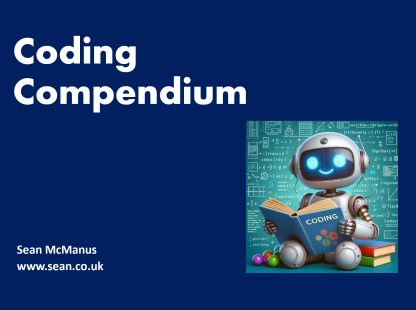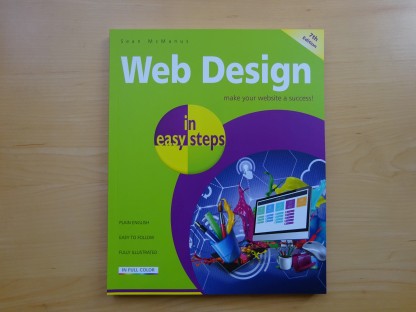
Coding Compendium
A free 100-page ebook collecting my projects and tutorials for Raspberry Pi, micro:bit, Scratch and Python. Simply join my newsletter to download it.
Sean McManus, co-author of Raspberry Pi For Dummies, reports on BETT 2013, the learning technology exhibition and conference, where he discovered how the Raspberry Pi is being used in classrooms.
Prof, the character of online maths tutor Maths-Whizz, welcomes me to BETT
Who was the star of BETT 2013, the learning technology event? Professor Brian Cox had them queuing around the block, but (for me, at least) the real star of the show was the Raspberry Pi. This year's show was the first one since the Raspberry Pi was released, and it seemed to pop up all over the place. There were a few key sessions where teachers could get guidance on how they can incorporate the Pi in their lessons.
Clive Beale holds up a Raspberry Pi at BETT
Clive Beale, the Raspberry Pi Foundation's new Director of Educational Development, spoke at a session on "delivering computing in the classroom with (exam board) OCR and the Raspberry Pi". He introduced the Raspberry Pi, and its phenomenal success (it's sold nearly a million units now, and the original vision was to create just a few thousand). He then said that although the hardware has become a star, the mission has always been to get young people back into computing, and that's something the Raspberry Pi Foundation will be able to focus more of its attention on in 2013, with the support of OCR, and Google, which has announced it will fund 15,000 Raspberry Pis for schools.
One thing that came through clearly to me was how the Raspberry Pi is not just a different way of using a computer, but also a different philosophy for computing to the typical desktop computers we use today. Beale compared Windows, where you switch on and you're asked whether the antivirus should update or unused icons should be removed, with the Raspberry Pi, which deliberately boots into a command line interface. "You have to tell the computer what to do," he said. "You're immediately in an environment where you control the computer. You have to think about what you're doing."
Teachers (and parents) might be concerned about children and young people breaking the computer, but this is exactly the point. The Raspberry Pi is a safe playground for experimentation. Beale said the first thing he might do when teaching is to get the students to issue a command that deletes most of the OS, so they can immediately get experience with rebuilding it by reflashing the SD card. It means they will know how to recover their computers again. Students can also see that there are no safety barriers: if something is deleted because they deleted it, they'll know it's their fault.
Another thing that is clear is that the Raspberry Pi isn't just about building up technical skills. It can help with interpersonal skills too. Beale said that physical computing, using the GPIO to connect electronic circuits to the Raspberry Pi, is a great way to engage students and get them collaborating. The ideal number of Raspberry Pis for a class of 30 was said to be about 10, although even having 5 can be valuable.
Beale noted that the Raspberry Pi isn't a replacement for the desktop computers that schools already have. It would be silly, he said, to replace existing dual core machines with a Raspberry Pi, but the Pi can be a fantastic complement to the existing setup, especially if the PCs at the school have been locked down to stop students (and teachers!) experimenting with them.
Dancers from the Peridot professional dance group perform a robotic dance routine at BETT.
Lorna Panesar, head of IT at Emmbrook School, spoke about how the Raspberry Pi can be brought into teaching. One of the things she emphasised is that teachers should not be afraid to learn with their students. The main thing I took away from her talk was how the Raspberry Pi gives students first-hand experience of things that previously they had to imagine.
She said that pupils often don't know the difference between the operating system and hard disk or whether the keyboard is part of the computer. Whereas they previously had to imagine what was inside the computer, teachers can now allow pupils to see what makes up a computer, without making the technical support team go grey at the thought of pupils poking around inside PCs. "It doesn't matter if they wipe the whole lot," she said. "Let them play with it." When pupils come to answer questions about using a command line interface, they will be able to write from their own experience. It's completely different to just having it demonstrated by the teacher. Pupils can also understand networking much better if they've actually built their own network using the Raspberry Pi. The Pi brings scientific experimentation to computer science, rather than relying on teacher-led demonstrations which don't fully engage pupils.
The crowd gathers around Rob Bishop (on the right), as he demonstrates how to make a jelly baby sing. Photo by Phil Tobitt.
Natalie Robson, the resource project manager, spoke on behalf of OCR (Oxford, Cambridge and RSA Examinations). OCR has created a suite of resources to help teachers to get up and running with the Raspberry Pi quickly, and will also be working with Google to distibute the 15,000 Rasperry Pis that Google is donating to UK schools. (They're still working out how these will be allocated, but Simon Banks, qualifications group manager at OCR, said they are committed to getting them into the hands of students and teachers who will use them and get the most benefit from them). Robson said that there are now five classroom challenges that can be downloaded for free from the OCR website. The resources aim to give teachers the confidence to use the Raspberry Pi in the classroom, and include learner and teacher sheets for projects including simple animation and connecting to a network.
The OCR stand also played host to some demonstration sessions led by Rob Bishop of the Raspberry Pi Foundation. He demonstrated how to connect an LED to the Raspberry Pi, and then use a simple Python script to make it flash, and then later on showed how to connect a jelly baby to the Raspbery Pi so that it "sings" (plays an MP3) when you squeeze it. The beauty of both of these demonstrations is that they don't require any soldering, and OCR was handing out simple instruction sheets that teachers and students can follow to repeat the experiments at home. As you can see from my photo above, the second session on the Friday was packed, with people filling the stand and spilling into the surrounding walkways.
At BETT 2013, there was clearly a real buzz around the Raspberry Pi. Some teachers I spoke to were a bit nervous about using it, because it is so different to what they've been teaching before, but they were excited at the opportunity to give students first hand experience of computer science. The Raspberry Pi is having an impact across other parts of the curriculum too. HPC Laser, which makes tools for woodwork and technology lessons, had wooden machine-cut Raspberry Pi cases. I wonder how many pupils will be making and decorating their own Raspberry Pi cases, creating their own electronics circuits in their technology lessons, and then programming them in computer clubs after school?
Voyage, an art installation at Canary Wharf, powered in part by the Raspberry Pi.
I finished my day by going to Canary Wharf, where Aether & Hemera have an art installation partly operated by the Raspberry Pi, which consists of lots of paper boats with lights inside them that viewers can control using their mobile phones. If you're in the area, it's worth taking a look, and it's there until Friday 15th February. This is a great example of how the Raspberry Pi isn't just for science, but can also be for art.
© Sean McManus. All rights reserved.
Visit www.sean.co.uk for free chapters from Sean's coding books (including Mission Python, Scratch Programming in Easy Steps and Coder Academy) and more!

A free 100-page ebook collecting my projects and tutorials for Raspberry Pi, micro:bit, Scratch and Python. Simply join my newsletter to download it.

Web Design in Easy Steps, now in its 7th Edition, shows you how to make effective websites that work on any device.

Power up your Microsoft Excel skills with this powerful pocket-sized book of tips that will save you time and help you learn more from your spreadsheets.

This book, now fully updated for Scratch 3, will take you from the basics of the Scratch language into the depths of its more advanced features. A great way to start programming.

Code a space adventure game in this Python programming book published by No Starch Press.

Discover how to make 3D games, create mazes, build a drum machine, make a game with cartoon animals and more!